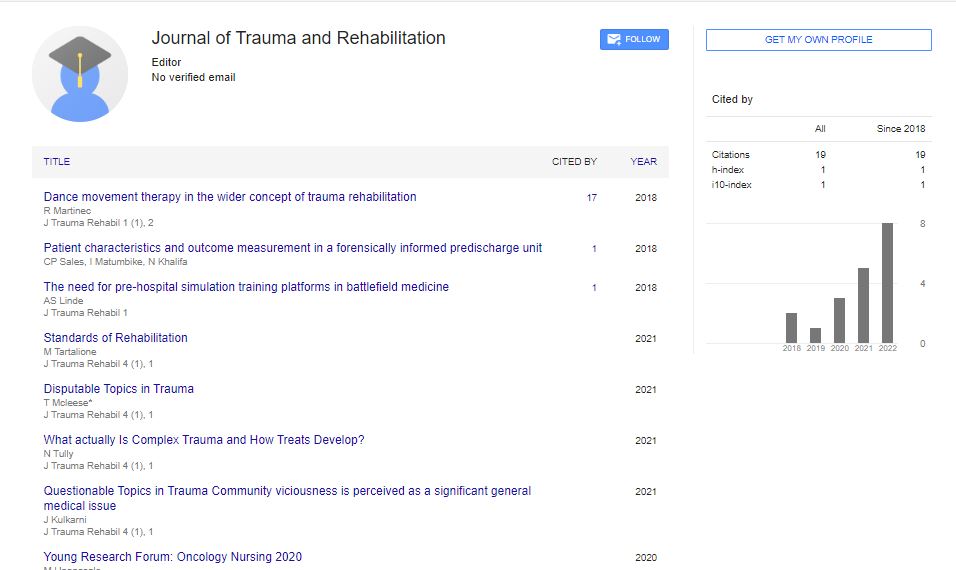Commentary, J Trauma Rehabil Vol: 6 Issue: 3
Exploring the Strategies and Mechanisms of Suicidal Trauma
Tayler Clinze*
1Department of Psychiatry, University of Alberta, Edmonton, Canada
*Corresponding Author: Tayler Clinze,
Department of Psychiatry, University of
Alberta, Edmonton, Canada
E-mail: Tayler_clinze@ua21.ca
Received date: 23 August, 2023, Manuscript No. JTR-23-118517;
Editor assigned date: 25 August, 2023, PreQC No. JTR-23-118517 (PQ);
Reviewed date: 08 September, 2023, QC No. JTR-23-118517;
Revised date: 15 September, 2023, Manuscript No. JTR-23-118517 (R);
Published date: 22 September, 2023, DOI: 10.4172/Jtr.1000136
Citation: Clinze T (2023) Exploring the Strategies and Mechanisms of Suicidal Trauma. J Trauma Rehabil 6:3.
Description
Suicidal trauma is a complex and deeply distressing experience that affects individuals in a myriad of ways. It is essential to explore not only the mechanisms and underlying factors that contribute to suicidal trauma but also the strategies for preventing and reducing its devastating impact. Suicidal trauma is a psychological state characterised by an overwhelming sense of hopelessness, despair, and emotional pain. It is the result of a confluence of factors, often involving mental health issues such as depression, anxiety, or posttraumatic stress disorder, coupled with external stressors like financial problems, relationship conflicts, or the loss of a loved one. The mechanisms of suicidal trauma can be broken down into several key components.
Individuals grappling with suicidal trauma often experience intense emotional pain. This may stem from unresolved grief, overwhelming anxiety, or feelings of worthlessness. A pervasive sense of hopelessness, where individuals feel that there is no way out of their emotional pain, is a hallmark of suicidal trauma. Social isolation and a lack of support systems can contribute to the development of suicidal trauma. When individuals feel abandoned or disconnected from others, their emotional suffering intensifies.
Experiences of bullying or discrimination can intensify emotional distress and feelings of worthlessness, further contributing to suicidal trauma. Individuals facing suicidal trauma may employ improper coping mechanisms, such as substance abuse or self-harm, to alleviate their emotional pain, leading to a vicious cycle of despair. Major depressive disorder is often a co-occurring condition with suicidal trauma. The sense of melancholy and hopelessness associated with depression can amplify suicidal thoughts and behaviors. Severe anxiety, especially when untreated, can lead to the deterioration of one's mental and emotional well-being.
Preventing and reducing suicidal trauma requires a multifaceted approach, addressing both individual and societal aspects. Recognising and addressing mental health issues like depression and anxiety in their early stages can significantly reduce the risk of suicidal trauma. Empowering individuals with healthy coping mechanisms can provide them with tools to navigate through emotional distress without resorting to self-destructive behaviours.
Building and maintaining strong social networks can act as a protective buffer against suicidal trauma. These connections provide emotional support during difficult times. Providing accessible crisis helplines and telephone numbers can be a lifeline for those in immediate need. Reducing the stigma surrounding mental health issues is important. Open communication and education about mental health can encourage individuals to seek help without fear of judgement.
Educating family members, friends, and professionals about the warning signs of suicidal trauma can facilitate early intervention. Ensuring that potentially lethal means are securely stored can prevent impulsive actions during moments of crisis. Individuals who have experienced suicidal trauma require ongoing support and aftercare to ensure that they continue to receive the help they need.
Conclusion
Suicidal trauma is a complex and devastating condition that demands our collective attention. By understanding the mechanisms that underlie suicidal trauma and implementing comprehensive prevention strategies, one can help individuals find possibility and healing in their darkest moments. Access to mental health services, strong support networks, and destigmatization efforts are vital components of suicide prevention. With these strategies, one can develop a world where individuals facing suicidal trauma receive the help and understanding they need to rebuild their lives and find renewed hope. Suicidal trauma is a complex, multifaceted issue, but with the right strategies and unwavering support, one can help those who are suffering find the strength to carry on and discover a path towards a brighter future.
 Spanish
Spanish  Chinese
Chinese  Russian
Russian  German
German  French
French  Japanese
Japanese  Portuguese
Portuguese  Hindi
Hindi 